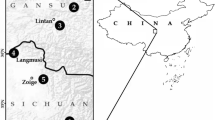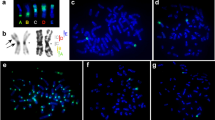Abstract
THE karyotypes of two supposed sub-species of the European hedgehog1 were investigated by the use of bone marrow preparations. Two hedgehogs of each sex were caught in the Siebengebirge area near Bonn, Federal German Republic. They were recognized as belonging to the sub-species Erinaceus europaeus europaeus L. 1758, with a brownish coloured chest2,3. The modal diploid chromosome number was 48 as previously noted by Painter4 and Bovey5. In Fig. 1a the karyotype of a male animal of E. e. europaeus is shown. Several of the autosomes are easily identified, namely, two large sub-acrocentrics, one medium sized acrocentric and two remarkably small metacentrics. They are labelled tentatively as a, Nos. 2, 3, 21, 22 and 23 respectively. There is an XX–XY sex determining mechanism. Using tritiated thyrmdme for labelling, the X chromosome could be ascertained as one of the moderately large metacentrics. The Y chromosome is a very small sub-metacentric, scarcely larger than the autosomes No 22 and 23.
This is a preview of subscription content, access via your institution
Access options
Subscribe to this journal
Receive 51 print issues and online access
$199.00 per year
only $3.90 per issue
Buy this article
- Purchase on Springer Link
- Instant access to full article PDF
Prices may be subject to local taxes which are calculated during checkout
Similar content being viewed by others
References
Ellerman, J. R., and Morrison-Scott, T. C. S., Checklist of Palaearctic and Indian Mammals 1758 to 1946 (London (Brit. Mus.) 1951).
Brohmer, P., Fauna von Deutschland, ninth edition (Quelle and Meyer Heidelberg, 1964).
Herter, K., Die Biologie der Europäischen Igel, Monograph. d. Wildsäugetiere, Band V (Verlag Dr. Paul Schöps, Leipzig 1938).
Painter, T. S., Amer. Nat., 59, 385 (1925).
Bovey, R., Rev. Suisse de Zool., 56, 371 (1949).
Ford, C. E., Hamerton, J. L., and Sharman, G. B., Nature, 180, 392 (1957).
Meylan, A., thesis, Univ. Lausanne (1964).
Matthey, R., Arch. Biol., 75, 169 (1964). Matthey, R., Chromosoma (Berlin), 18, 188 (1966).
Chu, E. H. Y., and Swomley, B. A., Science, 133, 1925 (1961).
Benirschke, K., and Malouf, N., Second International Symposium for the Preservation of the Feral Horse (Berlin, January, 1965).
Author information
Authors and Affiliations
Rights and permissions
About this article
Cite this article
GEISLER, M., GROPP, A. Chromosome Polymorphism in the European Hedgehog Erinaceus europaeus (Insectivora). Nature 214, 396–397 (1967). https://doi.org/10.1038/214396a0
Issue Date:
DOI: https://doi.org/10.1038/214396a0
This article is cited by
-
The Robertsonian phenomenon in the house mouse: mutation, meiosis and speciation
Chromosoma (2014)
-
New developments in vertebrate cytotaxonomy IX Chromosome numbers in the order Insectivora (Mammalia)
Genetica (1986)
-
Karyotypvariation und Heterochromatinmuster bei Igeln (Erinaceus und Hemiechinus)
Chromosoma (1969)
Comments
By submitting a comment you agree to abide by our Terms and Community Guidelines. If you find something abusive or that does not comply with our terms or guidelines please flag it as inappropriate.



